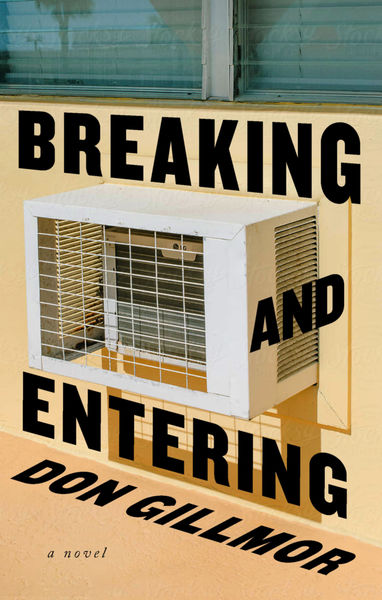Don Gillmor on Families, Secrets, & the Lockpicking Mom in His Brilliant New Novel
In Don Gillmor's new novel, Breaking and Entering (Biblioasis), Beatrice Billings is stuck in the middle-est of middles. At 49, she's dealing with a stagnant marriage, an ailing mother, and a son who will barely speak to her outside of puzzling text messages. Add an off-the-charts sweltering Toronto summer into the mix, and Bea is as fed up as the steaming city and just as ready to melt down. She sits down and Googles a signal word that changes everything: "escape".
What she finds isn't marriage advice or parenting support: it's an online community dedicated to amateur lock-picking. Before she knows it, Bea finds herself breaking into houses—dangerously close-by houses—in the night. Inside she finds evidence of the former selves she longs to return to: newlyweds, young singles celebrating the freedom of the city, new parents. But as time goes on, Bea finds herself needing more to keep from boiling over, and her compulsions begin to put everyone at risk.
A searing tale of midlife, the need to be seen, and how easy it is to lose oneself by slow degrees, Breaking and Entering is written with Gillmor's trademark power and insight, a novel of depth and painful truths filtered through strikingly rendered characters. Bea's story asks questions about safety, assumptions, and identity in an urgent way that keeps readers engaged to the final page.
Gillmor is a decorated writer, having won the Governor General's Literary Award for nonfiction and been nominated twice for his children's books. He's the author of three acclaimed novels for adults, and formerly served as a Senior Editor for The Walrus. He joins us today to discuss Breaking and Entering, telling us how interesting it was to explore a married couple who don't realize how much they don't know about one another, how "every novel imparts is own lessons" (and what this one taught him), and how he had to learn to pick locks – but just, he promises, for research.
Open Book:
Do you remember how your first started this novel or the very first bit of writing you did for it?
Don Gillmor:
I wrote a short story about a young man who broke into houses and found a diary of a young woman in a basement apartment and took it. He fell in love with the writer of the diary and was able to woo her as he knew her most intimate thoughts. They end up living together and he tells her he works in security and leaves the house every morning, off to break into houses.
I liked the idea of how we often don’t know as much as we think about our partners. I decided to take that idea and run it through the lens of a middle-aged woman. She doesn’t know her husband is having an affair (though she finds out and has one of her own), and he doesn’t know she’s breaking into houses.
OB:
How did you choose the setting of your novel? What connection, if any, did you have to the setting when you began writing?
DG:
The actual neighbourhood that Bea lives in isn’t identified, though it is a version of my own Toronto neighbourhood – Riverdale. It is a logical middle-class place for Bea and one I’m deeply familiar with. In a larger sense, we get a glimpse of Toronto’s glaring issues – the monstrous traffic, which on some lists beats out L.A. and New York for worst on the continent. It is wonderfully balanced by our tragically limited public transit system.
OB:
Did the ending of your novel change at all through your drafts? If so, how?
Your CanLit News
Subscribe to Open Book’s newsletter to get local book events, literary content, writing tips, and more in your inbox
DG:
The ending did change. I sometimes envy those writers who write the last line first and know exactly where they are going. I wanted the ending to be a bit ambiguous so needed to tinker with it so it was ambiguous but not opaque.
OB:
Did you find yourself having a "favourite" amongst your characters? If so, who was it and why?
DG:
The main character, Bea, is my favourite, has to be my favourite really, as I spend so much time in her head. But Roger, the former philosophy professor turned real estate agent would be a close second. It’s always fun to write a character with a caustic wit.
OB:
If you had to describe your book in one sentence, what would you say?
DG:
Breaking and Entering is the story of middle-aged love with all its complications, pressures, and unfulfilled desires, set against the coming apocalypse, and seen through the eyes of a 50-year-old woman whose new hobby is breaking into houses.
OB:
Did you do any specific research for this novel? Tell us a bit about that process.
DG:
The main character breaks into houses and to do so, she has to learn how to pick locks. I was surprised that there are hundreds of lock picking clubs across the continent. You have to wonder why they need that skill. I did look into how locks worked and how to pick them. It isn’t quite as easy as it is in the movies, though it’s not as hard as I thought. Though I didn’t break into any of my neighbour’s homes.
OB:
Did you include an epigraph in your book? If so, how did you choose it and how does it relate to the narrative?
DG:
I used two epigraphs – one from the Marquis de Sade about the joys associated with “making off with the substance of others.” The other is from Rainer Maria Rilke’s Duino Elegies – “But Nature, spent and exhausted, takes lovers back into herself, as if there were not enough strength to create them a second time.” The novel is about the nature of love and about Nature herself. It is the hottest summer on record, as our current summer is globally. Weather has become a crucible of sorts – how do we survive the heat and fires and rising seas, and how does love survive.
OB:
What if, anything, did you learn from writing this novel?
DG:
Every novel imparts is own lessons. To write from the perspective of a 50-year-old woman I talked to several female friends. Hopefully some of what I learned is glimpsed in the characters of Bea and her sister.
________________________________________________
Don Gillmor is the author of To the River, which won the Governor General’s Award for nonfiction. He is the author of three novels, Long Change, Mount Pleasant, and Kanata, a two-volume history of Canada, Canada: A People’s History, and nine books for children, two of which were nominated for the Governor General’s Award. He was a senior editor at The Walrus, and his journalism has appeared in Rolling Stone, GQ, The Walrus, Saturday Night, Toronto Life, the Globe and Mail, and the Toronto Star. He has won twelve National Magazine Awards and numerous other honours. He lives in Toronto.




